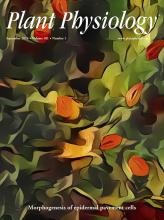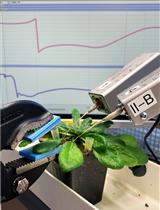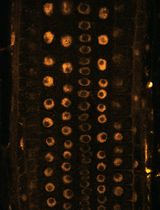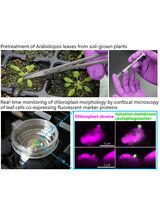- EN - English
- CN - 中文
Quantification of Protein Enrichment at Plasmodesmata
胞间连丝富集蛋白的量化分析
发布: 2020年03月05日第10卷第5期 DOI: 10.21769/BioProtoc.3545 浏览次数: 5426
评审: Ali ParsaeimehrTohir BozorovAnonymous reviewer(s)
Abstract
Intercellular communication plays a crucial role in the establishment of multicellular organisms by organizing and coordinating growth, development and defence responses. In plants, cell-to-cell communication takes place through nanometric membrane channels called plasmodesmata (PD). Understanding how PD dictate cellular connectivity greatly depends on a comprehensive knowledge of the molecular composition and the functional characterization of PD components. While proteomic and genetic approaches have been crucial to identify PD-associated proteins, in vivo fluorescence microscopy combined with fluorescent protein tagging is equally crucial to visualise the subcellular localisation of a protein of interest and gain knowledge about their dynamic behaviour. In this protocol we describe in detail a robust method for quantifying the degree of association of a given protein with PD, through ratiometric fluorescent intensity using confocal microscopy. Although developed for N. benthamiana and Arabidopsis, this protocol can be adapted to other plant species.
Keywords: Plasmodesmata (胞间连丝)Background
Currently, confirmation of protein localization to PD by confocal imaging is based primarily on two different approaches. On the one hand, the molecular composition of the cell wall surrounding PD differs. While the cell wall is highly enriched in cellulose, the environment near the PD is enriched in callose, a beta (1-3) glucan polymer that can easily and specifically be stained with fluorophore Aniline Blue. This staining presents the considerable advantage of being used as a PD marker without crossed lines. On the other hand, proteomic studies have identified specific PD proteins and led to their characterization (Faulkner et al., 2005; Fernandez-Calvino et al., 2011; Grison et al., 2015; Brault et al., 2019). These proteins can be used as PD markers in subsequent studies when tagged with fluorescent proteins in transient or stable expression in plants (Thomas et al., 2008; Simpson et al., 2009). Note that PD proteins can be exclusively associated with PD but can also present a dual localization within different cellular compartments as for Synaptotagmin1 (SYT1), Multiple C2 domains and Transmembrane regions Protein 4 (MCTP4) which associate with both the Endoplasmic Reticulum and PD (Levy et al., 2015; Brault et al., 2019). Since PD are dynamic structures responding to developmental and environmental cues, their molecular constituents may vary conditionally (Benitez-Alfonso et al., 2013; Stahl et al., 2013; Han et al., 2014; Sager and Lee, 2014; Otero et al., 2016; Stahl and Faulkner, 2016). Thus, Receptor Like Kinases (RLKs), such as the Leucine-Rich-Repeat RLKs Qian Shou Kinase 1 (QSK1) and Inflorescence Meristem Kinase 2 (IMK2) or the Cystein-Rich Receptor Kinase 2 (CRK2), are able to dynamically relocate to PD upon osmotic stress conditions (Grison et al., 2019; Hunter et al., 2019). The study of the dynamic localization of protein in vivo requires the development of quantification methodologies. Using confocal microscopy, we developed a ratiometric calculations to evaluate the PD enrichment of a given protein using PD markers, hereinafter referred as “PD Index”. The PD Index can be used for co-localization experiments but also as reference points for characterizing mutants, drugs or growing conditions that could modify the degree of proteins PD association (Perraki et al., 2018; Brault et al., 2019; Grison et al., 2019).
Materials and Reagents
- Syringe without needle (1 ml, Dutscher, catalog number: 8SS01H1 )
- Razorblade (19 x 38 x 0.27 mm, Dutscher, catalog number: 320529 )
- Slides (76 x 26 mm, Dutscher, catalog number: 0 6962 )
- Coverslips (22 x 32 mm, Dutscher, catalog number: 100034M )
- Tweezer (Pince à écharde forme pointue, Dutscher, catalog number: 711197 )
- Plant material (see Procedure A)
- Aniline Blue (Biosupplies Australia, catalog number: 100.1 ), storage at 4 °C
Note: The Aniline Blue stock solution is 1 mg/ml in water. The Aniline Blue working solution is 0.025 mg/ml. Do not use higher concentration of aniline bleu when the protein of interest is GFP tagged otherwise the Aniline Blue signal will crosstalk with the GFP signal. - Distilled water
- Luria and Bertani medium (LB broth Miller, Sigma-Aldrich, catalog number: L3152 )
- Sucrose (Sigma-Aldrich, catalog number: S7903 )
Equipment
- Confocal Microscope: plant imaging was performed using a ZEISS microscope (ZEISS, model: LSM880 )
- 28 °C Shaking Incubator (Dutscher, MaxQ 4000, catalog number: 0 78381 )
- Centrifuge (Dutscher, Spectrafuge 6 C for 10 ml tubes, catalog number: 0 96610 )
Software
- FIJI (https://imagej.net/Fiji) (Schindelin et al., 2012)
- R (https://www.r-project.org) (R Core Development Team, 2015)
Procedure
文章信息
版权信息
© 2020 The Authors; exclusive licensee Bio-protocol LLC.
如何引用
Readers should cite both the Bio-protocol article and the original research article where this protocol was used:
- Grison, M. S., Petit, J. D., Glavier, M. and Bayer, E. M. (2020). Quantification of Protein Enrichment at Plasmodesmata. Bio-protocol 10(5): e3545. DOI: 10.21769/BioProtoc.3545.
- Grison, M. S., Kirk, P., Brault, M. L., Wu, X. N., Schulze, W. X., Benitez-Alfonso, Y., Immel, F. and Bayer, E. M. (2019). Plasma membrane-associated receptor-like kinases relocalize to plasmodesmata in response to osmotic stress. Plant Physiol 181(1): 142-160.
分类
植物科学 > 植物细胞生物学 > 细胞间通讯
生物化学 > 蛋白质 > 表达
细胞生物学 > 细胞成像 > 共聚焦显微镜
您对这篇实验方法有问题吗?
在此处发布您的问题,我们将邀请本文作者来回答。同时,我们会将您的问题发布到Bio-protocol Exchange,以便寻求社区成员的帮助。
Share
Bluesky
X
Copy link













